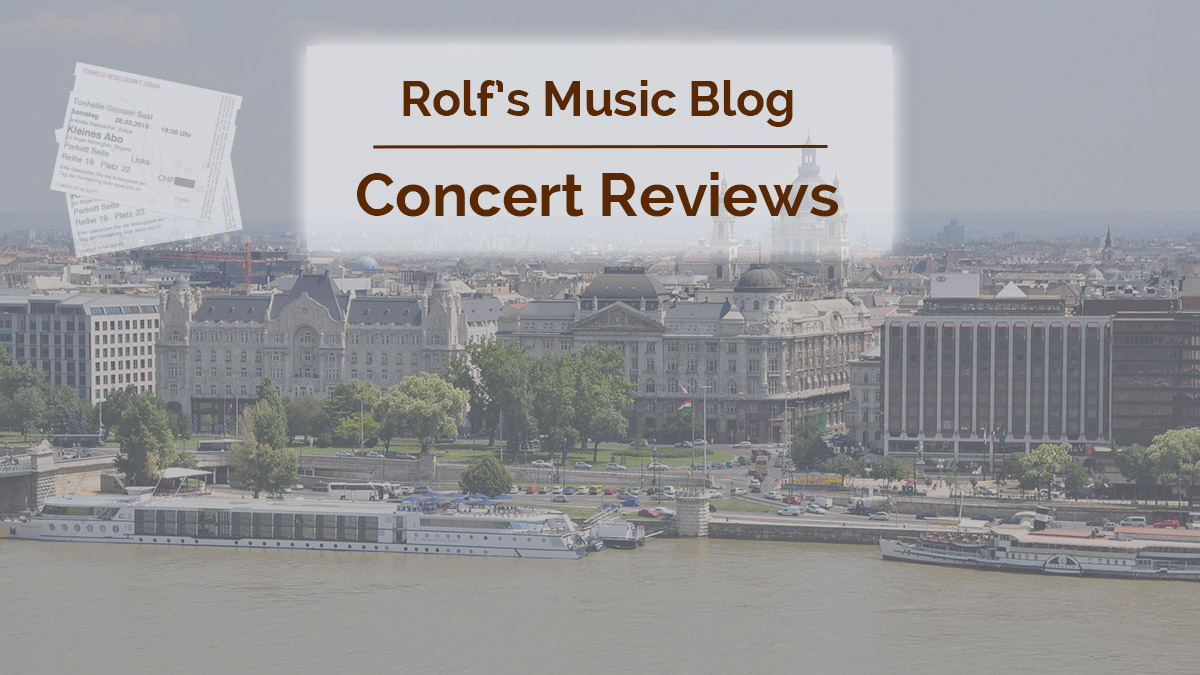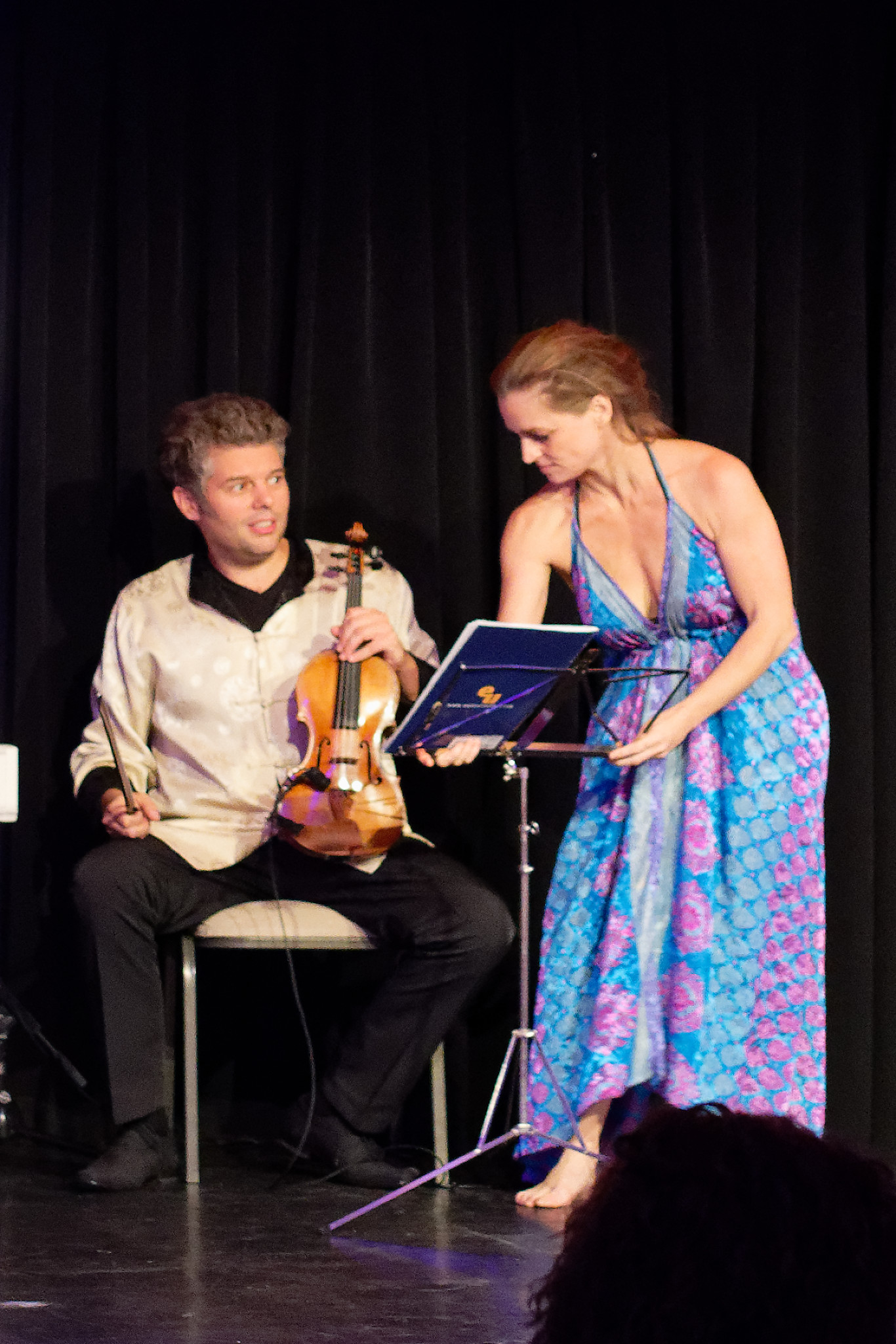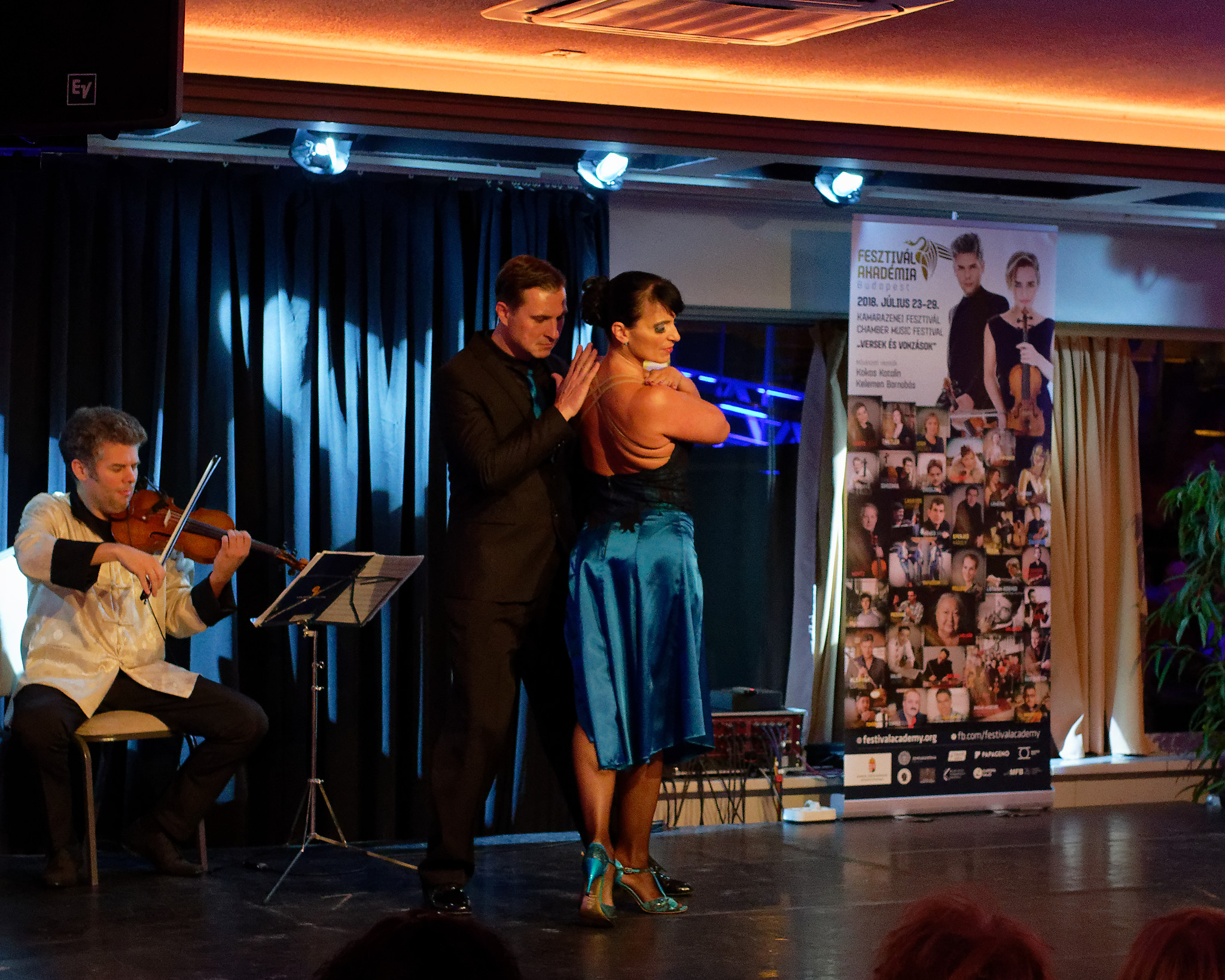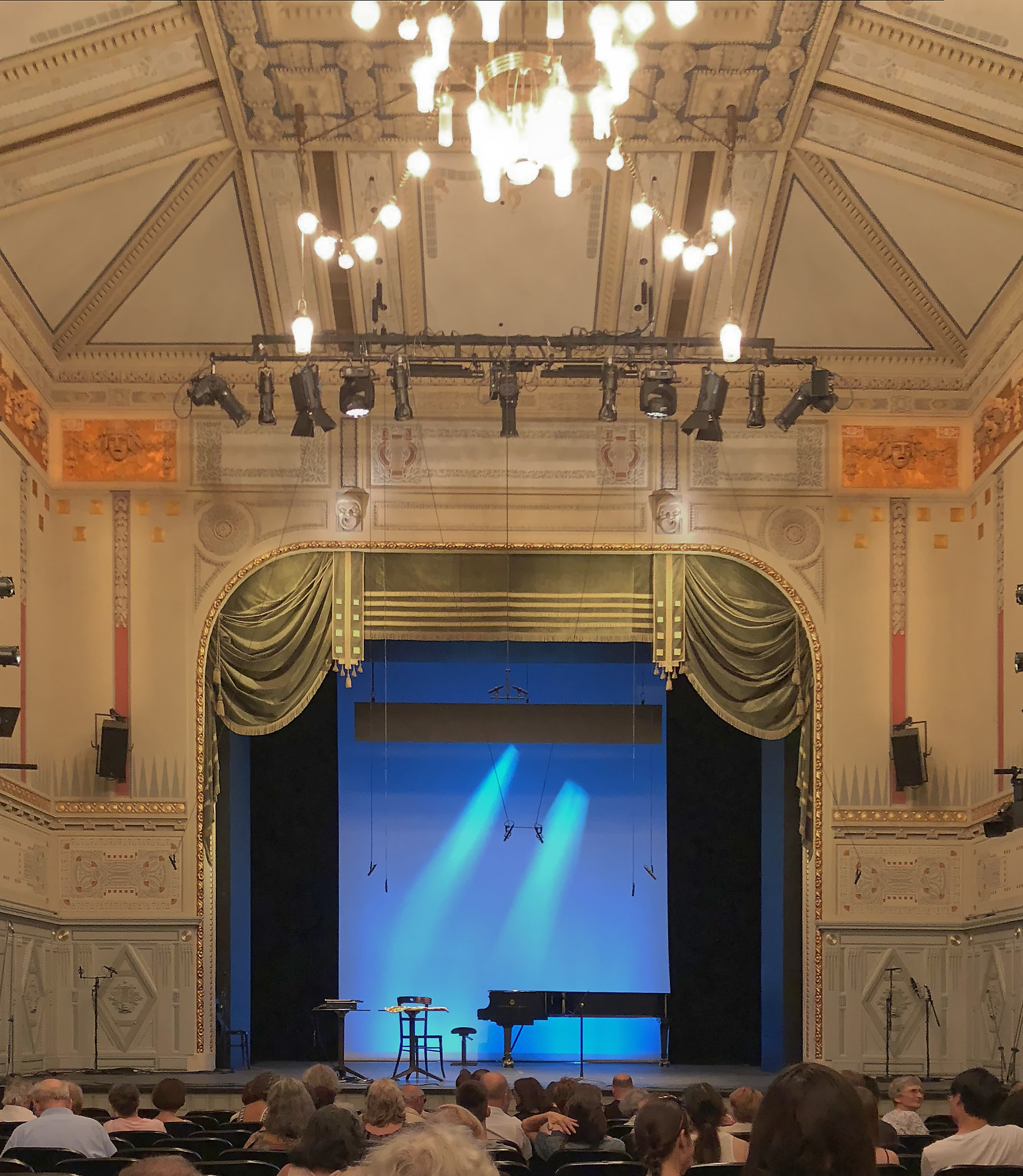Concert “Music has Soul”:
Bach / Straight Labyrinth / Romany Music / Argentine Tangos
Festival Academy Budapest 2018, Day 4
Budapest / Danube — 2018-07-26
2018-08-07 — Original posting
Table of Contents
Introduction
This is #3 out of six postings relating to this year’s Festival Academy Budapest, running from 2018-07-23 up till 2018-07-29. For general information on the Festival Academy see my first posting. In this note, I’m writing about the evening of 2018-07-26, a concert and sightseeing trip on the Danube, aboard the boat “Európa”. In addition, I’m touching upon a lecture given by Barnabás Kelemen in the afternoon of that same day.
That day, I attended three “Open Master Class” sessions. However, for all of these, I also experienced the corresponding concert performance in the upcoming “Master & Students” Concerts. Along with the discussion of these concert performances, I’m also referring back to the Open Master Class session, at least with photos. See the (upcoming) separate posts for 2018-07-27 and on 2018-07-28.
All pictures below are © Rolf Kyburz, all rights reserved.
Budapest Festival Academy, “Music has Soul”
This Concert’s Special Venue
In 2017, the Festival Academy Budapest offered one special concert “on the water”. That was an evening in the Széchenyi Spa, on 2017-06-12, then featuring Handel’s Water Music, to an audience either in the water, or in a bathing suit. This third instance of the Festival Academy also had an evening relating to the water. Not so much in the music, but in that the concert on day 4 happened in a boat on the Danube. So, to attend the concert, listeners from the Pest side (where the Ferenc Liszt Academy of Music is located, and where ball other events of this year’s festival Academy are taking place) needed to cross the river to the Buda side of the Danube, offering a grandiose view onto the capital’s parliament building:
The actual concert took place on the main deck of the boat “Európa” (see the picture above), where a stage had been built along one side of the boat, the audience formed a semi-circle around the stage. The first two performances happened while the ship was still attached to the pier. The Romany Music was playing during the boat trip and for a while after the completion of the journey, and the evening ended with a tango performance by two dancers.
The seating capacity around the podium aboard the “Európa” was pretty much sold out.
Bach: Brandenburg Concerto No.3 in G major, BWV 1048
The “Brandenburg Concerti” by Johann Sebastian Bach (1685 – 1750) don’t need to be introduced—they are so popular. This special concert featured a performance of Brandenburg Concerto No.3 in G major, BWV 1048. It features “almost” three movements:
- (tempo ordinario)
- (Adagio)
- Allegro
The first movement does not have a tempo annotation. In baroque times, this indicated “tempo ordinario” (ordinary tempo), presumably referring to “common sense”, i.e., assuming that artists would find the “natural” (typically Allegro-like) tempo for such a movement. The second movement is written as two single chords—a cadence—with fermatas on each chord. This again assumes that the musician would play / improvise a cadenza, i.e., a short fantasy that would link the two chords, or fill the gap between the chords.
The Artists
The Brandenburg Concerto No.3 is scored for three violins, three violas, three cellos, and basso continuo. Most of the string artists from this Festival Academy were involved in this performance:
- Katalin Kokas, Dmitry Smirnov, & Attila Ökrös (*1990), violin
- Yuri Zhislin, Razvan Popovici, & Alexandre Dimcevski, viola
- Natalie Clein (*1977, see also Wikipedia), Danjulo Ishizaka, & Jan-Erik Gustafsson, cello
- Zsolt Fejérvári, double bass
- Soma Dinyés (*1975), harpsichord
With the special “sideways” setup on the ship “Európa”, i.e., with the audience being substantially wider than deep, the artists decided for a special stage arrangement. Each of the three audience-facing sides of the podium had one violinist, one violist, and one cellist. These surrounded a small continuo group with Zsolt Fejérvári playing the double bass, and Soma Dinyés playing a harpsichord.
The photos below give an impression of the setup. On the left, there were Razvan Popovici (viola), Danjulo Ishizaka (cello), and Dmitry Smirnov (violin). At the front of the podium, one can see Katalin Kokas (violin and lead artist), Natalie Clein (cello), and Yuri Zhislin (viola), and finally, on the far side, there were Attila Ökrös (violin), Jan-Erik Gustafsson (cello), and Alexandre Dimcevski (viola).
Instruments
OK, the harpsichord wasn’t quite a historic model. It was merely an electronic keyboard (Kawai) in “harpsichord” mode. However, in this context, this made little or no difference. After all, who would possibly want to set up a sensitive, delicate historic harpsichord (even if it were merely a replica) in an environment where nobody would hear the difference anyway? The keyboard being electronic, its volume could be adjusted to fit the needs of the acoustics on the ship. I checked the string instruments: most instruments were modern, with modern bows, but closer inspection revealed at least one violinist (Dmitry Smirnov) using a baroque bow.
The Setting
The special circumstances of this evening forbid applying standard concert review criteria. The performance of even just the baroque/classical part was heavily “bent”, adjusted to the circumstances:
- the acoustics were “special”, to say the least. The ship is not built as a concert venue, acoustic support is minimal, reverberation non-existent
- a ship is a noisy place. There are no measures to dampen audience noises in favor of the music; plus, even if the boat is stationary, and even if the kitchen is in the lower deck (as here), there is always the noise of some machinery, generators, etc.
- the special environment itself (be it only the excitement from experiencing a concert on a boat) further distracts from the music.
So, let’s not look back at this (especially the Bach performance) with the eyes of a critic. After all, people attended the event as an enriching experience of fun and pleasure, plus…
- in recognition of the artists which they know and like, hold in high esteem
- there was dinner and a 1.5 hours sightseeing tour on the Danube included—a social experience / gathering overall,
- there was Romany Music—so popular in this country, and
- a novel cross-over experience with a String Quartet and the InFusion Trio, and more…
The Performance
Despite what I just stated, I don’t want to diminish the musical performance with Bach’s famous concerto:
I. (tempo ordinario)
With all the high/top class musicians on the stage, the performance had all (well, most) attributes of a historically informed performance. It featured proper (as we know today) baroque articulation (light, discharging long notes, clear accents), a “talking” musical “syntax” (a.k.a. Klangrede, so far from the “sewing machine Bach” that was still popular 50 years ago!!), a fluent, vivid tempo (but not pushed to the limit).
Sure, there were limitations, not just in the acoustics, but maybe more so in the coordination, which must have been a real challenge to the musicians, who had their back turned towards (some of) their colleagues. However, perfection was not the goal here. Rather: the liveliness, a living performance, evoking what must have been Bach’s state of mind when he composed this music. Joy, fun, and highest level entertainment!
II. (Adagio)
Soma Dinyés inserted his cadenza prior to the two written chords with fermata. As stated, I don’t want to be too critical here. After all, this was not ever a real harpsichord. It had the sound of plucked strings, but could hardly offer any of the richness in sound of a real instrument. If this had been a “proper” performance, I would have to state that the cadenza seemed rather long, too thematic, maybe also harmonically reaching out quite (too) far. I can’t exclude that at Bach’s time, this would have been an option. However, today, I prefer musicians to stay close to the composer. I would have preferred scales, arpeggiating, a free fantasy in the manner of stylus fantasticus, even if it ventured modulating excursions. This does not add external melodic / thematic material, hence fits more easily.
III. Allegro
Even though this movement is technically more virtuosic, it was less of a challenge, easier in terms of coordination, given its clear rhythmic base beat. If there were coordination issues, then mostly just when resuming after a fermata.
Overall, a joy to watch, fascinating music, a real pleasure to listen to! Katalin Kokas appeared to use “invisible strings” to keep her fellow musicians in line. And she was very good at that, given the circumstances: congrats!
Straight Labyrinth (InFusion Trio & String Quartet)
The next section featured the premiere of a cross-over classical / Pop performance, based on the poem “Egyenes Labirintus” (“Straight Labyrinth”) by János Pilinszky (1921 – 1981).
The Artists
- InFusion Trio
- Nándor Weisz, vocal & drums
- Izsák Farkas, violin
- Mihály Simkó-Várnagy, cello / bass
- Barnabás Kelemen & Katalin Kokas, violin
- Alexandre Dimcevski, viola
- Jan-Erik Gustafsson, cello
- Károly Eperjes (*1954), recitation
The Performance
The poem “Egyenes Labirintus” (along with other poems by János Pilinszky) was first recited by the famous Hungarian actor Károly Eperjes. Needless to say: the poem was in Hungarian language, so I didn’t draw much—if any—information about its contents. Nor, of course, could I gather how the poem relates to the music that followed. The recitation itself, its imaginative tone, the excellent diction were very impressive, though. He was “stealing the show” for a good while!
I do not relate to Pop music at all, so I have a hard time commenting on the pop aspects of that performance. The crossover aspect was very obvious, not just through the presence of the InFusion Trio in the back of the stage, but also because the string quartet was wearing headphones / earpieces, in order to maintain mutual contact—a must with all the amplification, the monitor loudspeakers, etc.
The Sound Experience
Sound-wise, all instruments were equipped with microphones, the sound amplified. This allowed adding reverberation, harmonic distortion / alteration, etc. The two string instruments of the InFusion Trio were electronic, not acoustic models. As far as I can tell, the music presented an interesting mix of pop elements (heavy tremolo on the Trio’s cello) with jazz elements (strongly rhythmic segments, syncopes, string solos) and contemporary classical music (harmonic and melodic aspects), with occasional influences from minimal music. And it was not nearly as much percussion-driven or monotonous as typical Pop music. I heard more Jazz than Pop, and enriched with interesting electronic sounds.
The term “crossover” tends to scare me off. However, I must confess that the performance here was a pleasure to listen to, and also suited for typical classical (definitely contemporary classical) audiences. It was nothing to be afraid of, but actually interesting, and also more than mere entertainment. It would be of interest to have a translation of the poem, and to figure out how that relates to the music.
Romany Music
The above performances were followed by a dinner buffet, and at the same time, the boat left for a 1.5 hour evening boat trip, first downstream, up to the Rákóczi bridge, then back again to the origin of the tour, at Szilágyi Dezsö tér. During most of the tour, and for a while after the return, there was a performance of Romany music on the stage, on the main deck. As far as I could tell, the majority of the passengers went upstairs, for the fabulous sightseeing in the evening’s warm summer weather. I certainly did so, as I had never been on a boat tour on the Danube. No, no pictures here from the sightseeing part. The Web is full of them already!
The Artists
The musicians for the Romany Music were the violin virtuoso Lajos Sárközy jr. (*1991) and his band of four—cimbalom, two violins (violin and viola?), double bass. The presenter announced Lajos Sárközy—a former pupil of Katalin Kokas—as “the world’s top violin virtuoso”.
The Performance
As I’m not an expert on Romany Music, I can’t give an “objective” comment on the performance by Lajos Sárközy and his band. All I can say is: the part that I heard (after returning from the sightseeing deck) was—as announced—extremely virtuosic, enthralling, simply excellent. Romany Music from the masters! Needless to say that Sárközy’s performance was hugely popular, the audience requested—and got—several encores.
The original program called for an acrobatic performance, also named “Egyenes Labirintus” (“Straight Labyrinth”). This was to be presented by an artist from the Budapest National Circus, accompanied by Lajos Sárközy and his band playing music from the film “Schindler’s List”. However, it turned out that the ceiling above the stage was too low, so that part was shifted to the very end (while people were already leaving the ship). It was performed in the front part of the main deck, just on the floor—with limited visibility for most of the audience, though.
Argentine Tangos
So, the next attraction that evening was a dance performance of Argentinean Tangos, by two professional dancers (the program did not state any names here). The music was provided by two prominent musicians of the Festival Academy Budapest:
- Barnabás Kelemen, violin
- José Gallardo (*1970), piano
The piano was of course again the keyboard, now in piano mode. From the looks, I would claim that the two musicians were—amazingly—sight-reading. However, that was just my visual impression, from what we heard, one would not have guessed that their performance was anything but a truly professional one. I’m not a dancer, so I’ll refrain from commenting the dance performance.
Afternoon Lecture @ Solti Hall: Barnabás Kelemen
The Festival Academy Budapest also offers a set of lectures, some in the smaller “Room X”, bigger, more popular ones at Solti Hall. The following lectures were programmed:
- Tuesday, 2018-07-24, 11:00 (Room X) — “The Russian Violin School”, presented by Natalia Lomeiko and her husband, Yuri Zhislin
- Thursday, 2018-07-26, 14:00 (Solti Hall) — “The Solo Violin Music of J.S. Bach”, presented by Barnabás Kelemen
- Saturday, 2018-07-26, 11:00 (Room X) — “Gershwin’s Piano Music”, presented by József Balog
- In addition, on July 24th, 25th, 27th – 29th, there were pre-concert lectures at 19:00 in the Solti Hall, presented by Gergely Fazekas,
Sadly, I wasn’t there for the first lecture on the Russian Violin School. That would definitely have been very interesting to hear. However, also Barnabás Kelemen‘s lecture sounded interesting. So, I attended the Thursday presentation.
I did that also in order to experience how these lectures work, how they fit into the context of the Festival Academy, and the level of interest that they generate.His presentation was the only one in the Solti Hall. Rightly so, as with Kelemen’s popularity in Budapest (and probably Hungary in general), there was a substantial audience in this venue.
The Lecture Experience
Barnabás Kelemen’s talk obviously dealt with topics around the six Partitas and Sonatas for Solo Violin, BWV 1001 – 1006 by Johann Sebastian Bach (1685 – 1750). Not unexpectedly, the lecture was in Hungarian. That’s a language in which I don’t know even the simplest phrases, such as “hello”, even “yes”, or “no”… Luckily, the organizers offered simultaneous translation via simple, portable headsets. However, the quality of that translation was limited, plus, worse even, the sound quality was so poor that after a while I preferred guessing what Barnabás was talking about. After all, I’m fairly familiar with these compositions, and I did mostly just attend for curiosity.
What did Barnabás Kelemen Talk About?
Barnabas Kelemen is an excellent, lively presenter. Even without understanding his words, I found it interesting to follow. The lecture dealt with two main topics
- using modern or period style instruments for these works, including issues such as neck and fingerboard steepness and length, gut strings, string tension, etc.—and their consequences for the volume and tone quality
- a major portion of the 1-hour presentation was devoted to Bach’s “secret hobby”, the fact that numeric symbols / numeric relations are omnipresent in his work, including these sonatas and partitas…
It’s definitely an utterly interesting feature in Bach’s music. However, for the average listener it doesn’t add much, if anything to enhance the listening experience (just my personal opinion, no insult intended!). Bach was a genius, and working numeric symbols and relationships must have been something that almost naturally was flowing into the composer’s works, maybe in the back of his mind. I think it’s entirely possible that Bach added some of the numeric symbolism even subconsciously, just as naturally as his mind was able to create themes that fit the scheme of a fugue, maybe even were fitting their own inversion, diminution, or expansion, and/or which work when played backwards, etc.
However, I didn’t mean to comment on Barnabás Kelemen’s lecture. As little as I understood from his words directly, what he was presenting was sufficiently clear from his slides (texts, manuscript samples, etc.) and definitely all made sense. And: Kelemen did end with a movement from one of Bach’s Partitas. He played on the period-style instrument, and using a baroque bow. I liked the performance, but as this was merely a teaser movement, I don’t want to comment on it any further.

























